Why you can trust Tom's Hardware
Our HDR benchmarking uses Portrait Displays’ Calman software. To learn about our HDR testing, see our breakdown of how we test PC monitors.
The 279M1RV delivers in the HDR department. Its 16-zone vertical dimming feature is effective and peak output goes way beyond the DisplayHDR 600 certification. Plus, it renders HDR color accurately.
HDR Brightness and Contrast
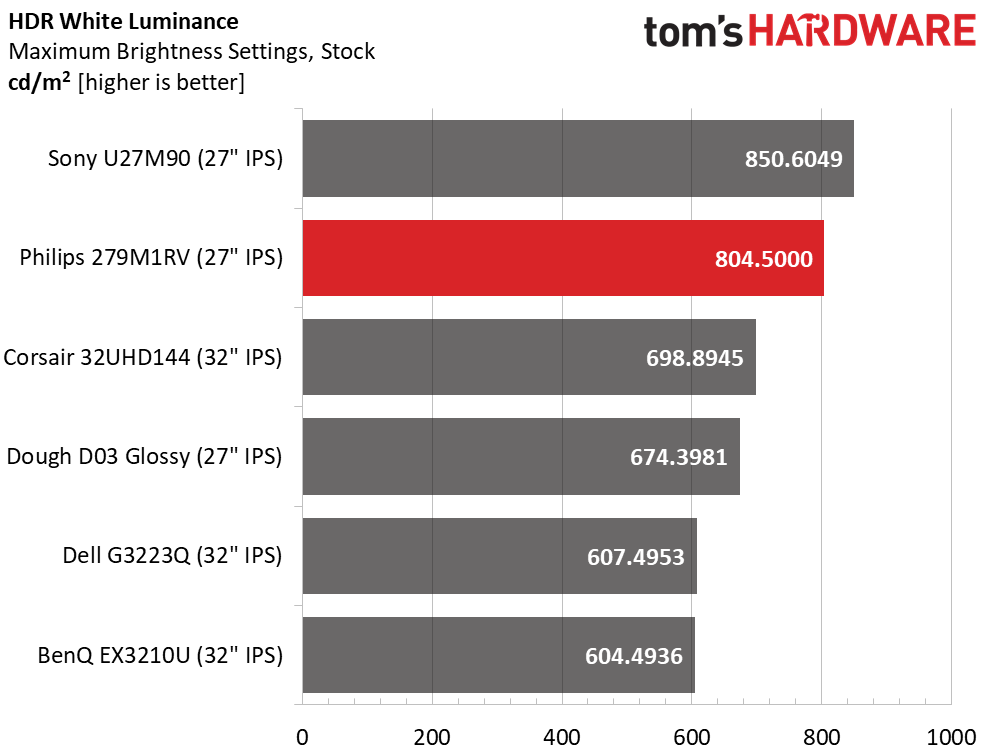

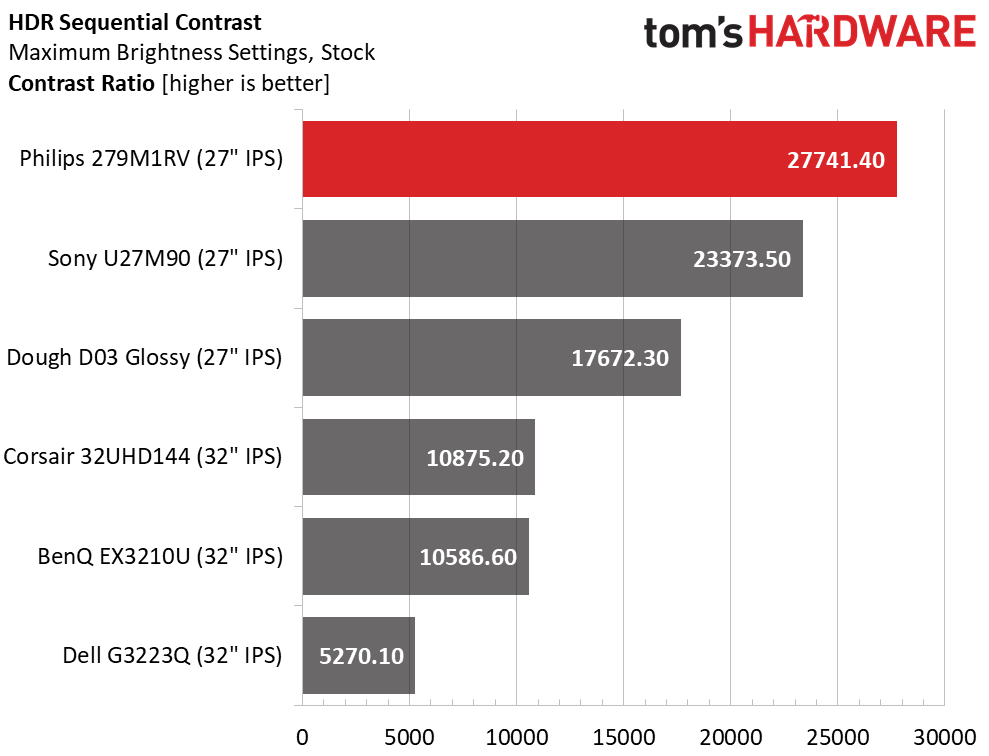
Though the Sony takes the top spot for HDR brightness, the 279M1RV handily beats the other displays. When considering LCD monitors, peak luminance is usually the spec that entices everyone. Though I consider overall contrast to be more important, I can say that Philips has addressed both aspects equally well. The black level leads the pack and takes it to the top spot with over 27,000:1 HDR contrast. The only way you’ll see better is from a FALD panel. And that will cost you nearly twice the money for a 27-inch screen. The 279M1RV delivers a lot of value with a superb HDR image.
Grayscale, EOTF and Color

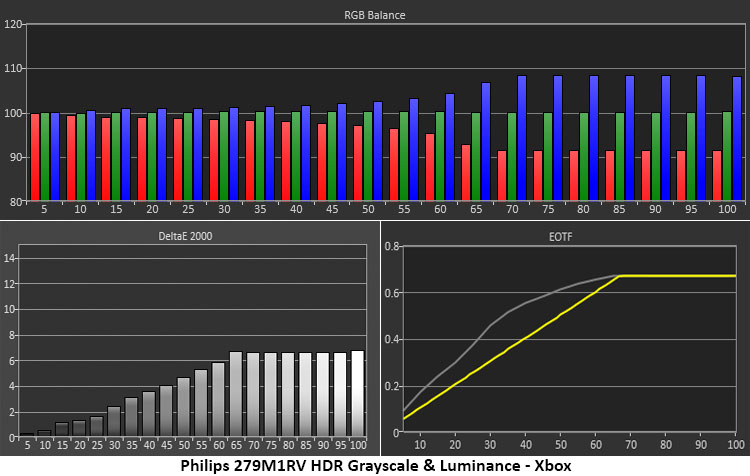
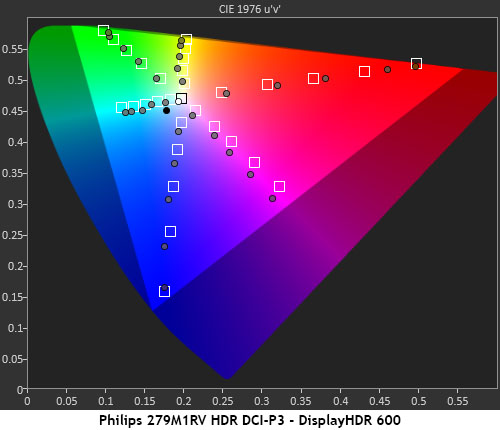

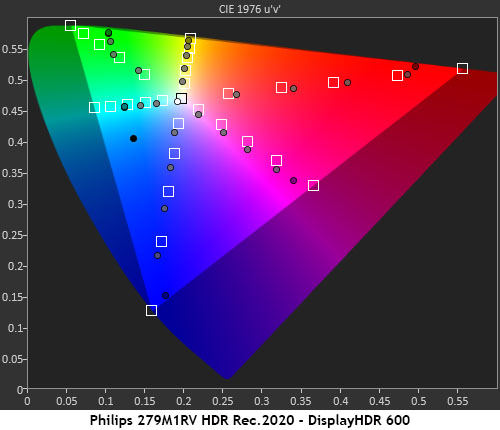

The 279M1RV offers six HDR modes, which can be a bit confusing. HDR is HDR and there is only one standard for luminance and color. That standard is met in the DisplayHDR 600 mode where you’ll not only get maximum brightness but decent accuracy. Grayscale runs a bit cool at the bright end of the scale, but the error isn’t too bad. There is no means to calibrate in this mode which is a bummer. The EOTF tracks almost perfectly with a tone-map transition point at 70%.
Comparing this with the Xbox mode shows a significant difference to the negative. Grayscale is more blue, which only serves to flatten the image. And the EOTF is far too light in tone. This robs the 279M1RV of contrast by raising low and mid-tone hues too much. That also serves to flatten the image. I advise avoiding the Xbox mode since it doesn’t look better. Xbox games are mastered to the correct HDR standards already.
HDR color tracking in DisplayHDR 600 mode is excellent for both DCI-P3 and Rec.2020. There is slight over-saturation of all colors, which is OK. Tracking is linear, so no detail is lost. Rec.2020 runs the same way with on-target performance until color runs out around 95%.
The Xbox mode creates a large gap in the color tracking where 20 and 40% targets are a little over-saturated, and higher values are very over-saturated. This creates a cartoonish look to bright content that I would call garish. Again, there is no need for a special Xbox mode. HDR content for this console is mastered to SMPTE standards for HDR10, just like every other game and video.
Get Tom's Hardware's best news and in-depth reviews, straight to your inbox.
MORE: Best Gaming Monitors
MORE: How We Test PC Monitors
MORE: How to Buy a PC Monitor: A 2022 Guide
MORE: How to Choose the Best HDR Monitor

Christian Eberle is a Contributing Editor for Tom's Hardware US. He's a veteran reviewer of A/V equipment, specializing in monitors. Christian began his obsession with tech when he built his first PC in 1991, a 286 running DOS 3.0 at a blazing 12MHz. In 2006, he undertook training from the Imaging Science Foundation in video calibration and testing and thus started a passion for precise imaging that persists to this day. He is also a professional musician with a degree from the New England Conservatory as a classical bassoonist which he used to good effect as a performer with the West Point Army Band from 1987 to 2013. He enjoys watching movies and listening to high-end audio in his custom-built home theater and can be seen riding trails near his home on a race-ready ICE VTX recumbent trike. Christian enjoys the endless summer in Florida where he lives with his wife and Chihuahua and plays with orchestras around the state.
-
cknobman "That means it won’t quite deliver the dynamic contrast of a full-array local-dimming (FALD) model, but it will render solid HDR with deep blacks and bright highlights. "Reply
Stopped reading right there.
I call bs as no IPS with edge lit dimming is actually capable of delivering a real HDR experience.
Then looked at price and laughed even harder. $750!!!
Phillips be smokin crack, LMAO -
Sergei Tachenov Reply
Absolutely. You need all three things to deliver any HDR experience: brightness, contrast and color gamut. And the contrast is what, 1000:1? Laughable. That's not "deep blacks." It's just a very bright SDR monitor with wide color gamut, nothing special. In fact, it's just the Philips version of the 27GP950, sharing the same panel.cknobman said:"That means it won’t quite deliver the dynamic contrast of a full-array local-dimming (FALD) model, but it will render solid HDR with deep blacks and bright highlights. "
Stopped reading right there.
I call bs as no IPS with edge lit dimming is actually capable of delivering a real HDR experience.
On an unrelated note, I wonder whether the KVM switch is as broken as in the 329M1RV. I'm 99% sure it is. Because they call it a KVM switch except... there is no freaking switch! There are exactly two ways to switch between the connected devices. The first, use the "auto-switch" feature: turn one PC off, the monitor will automatically switch to the other. The second, dig all the way through the OSD to find the carefully hidden switch functionality. And nope, you can't set it up to some shortcut, like moving the joystick into a certain direction.
This is the reason why I chose the M32U over the 329M1RV. Here, the switch comes with a lot of flaws, but at least it's there, and it actually works.
Philips has a very unique talent of making a horrible mess of UX. I had a Philips TV where plugging earphones in didn't mute the speakers. Instead, you had to mute them manually and then, to adjust the phones' volume, you had to dig through the menu to find it because the volume buttons on the remote control only controlled speakers regardless of whether earphones are connected.